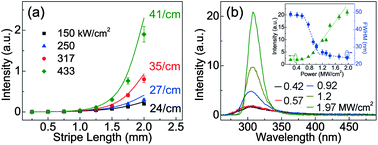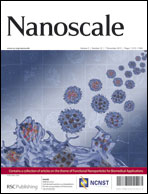Low threshold amplified spontaneous emission from tin oxide quantum dots: a instantiation of dipole transition silence semiconductors†
Abstract
Direct bandgap semiconductors, such as In2O3, Cu2O, and SnO2, have enormous applications in photochemistry, photovoltaics, and optoelectronics. Due to the same parity of conduction and valence bands, the dipole transition is silent in these direct bandgap semiconductors. The low band-to-band transition efficiency prevents them from high intensity light emission or absorption. Here, we report the fabrication of SnO2 quantum dots (QDs) with sizes less than the exciton Bohr radius by a facile “top-down” strategy based on laser fragmentation of SnO in water. The SnO2 QDs shows exciton emission at ∼300 nm with a high quantum yield of ∼17%. Amplified spontaneous exciton emission is also achieved from a thin layer of SnO2 QDs dispersed in PEG400 on a quartz substrate. Therefore, we have shown that SnO2 QDs can be a potential luminescent material suitable for the realization of ultraviolet B lasing devices.


 Please wait while we load your content...
Please wait while we load your content...